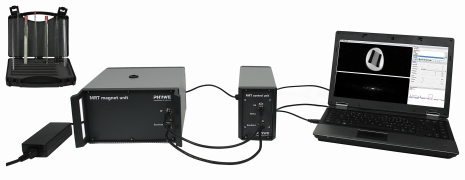Principle
The fundamental principles concerning the phenomenon of nuclear magnetic resonance (NMR) are demonstrated. Experiments are executed with a MRT training device giving the opportunity to investigate some small probes in the sample chamber. Investigations comprise the tuning of the system frequency to the Larmor frequency, the determination of the flip angle of the magnetisation vector, the effects of the substance quantity, the influence of particular magnetic field inhomogeneities, the measurement of a spin echo signal and an averaging procedure to maximise the signal-to-noise ratio. The adjustment of all parameters in these experiments are inevitable to obtain an adequate MR image in other experiments which can be performed with the same system without requiring any additional components.
Benefits
- Complete, easy to install and affordable MRT education system
- One system to cover all aspects from NMR basics to sophisticated 2D and 3D imaging sequences
- Detailed experiment guides included with the system
- Learning results guaranteed thanks to easy to manage course steps
- Can be set up at any location in the student lab
Tasks
- Tune the system frequency to the Larmor frequency
- Set the HF (High Frequency) pulse duration to determine the flip angle of the magnetisation vector
- Determine effects of the substance quantity on the FID signal (Free Induction Decay) amplitude
- Minimise magnetic field inhomogeneities via a superimposed magnetic field (shim)
- Retrieve a relaxated FID signal via a spin echo flipping nuclear spins by 180°
- Improve the signal-to-noise ratio (SNR) of the FID signal
Learning objectives
- Nuclear spins
- Atomic nuclei with a magnetic moment
- Precession of nuclear spins
- Magnetisation
- Resonance condition, MR frequency
- MR flip angle
- FID signal (Free Induction Decay)
- Spin echo
- Relaxation times (T1: longitudinal magnetisation, T2: transverse magnetisation)
- Signal-to-noise ratio
Software included. Computer not provided.
